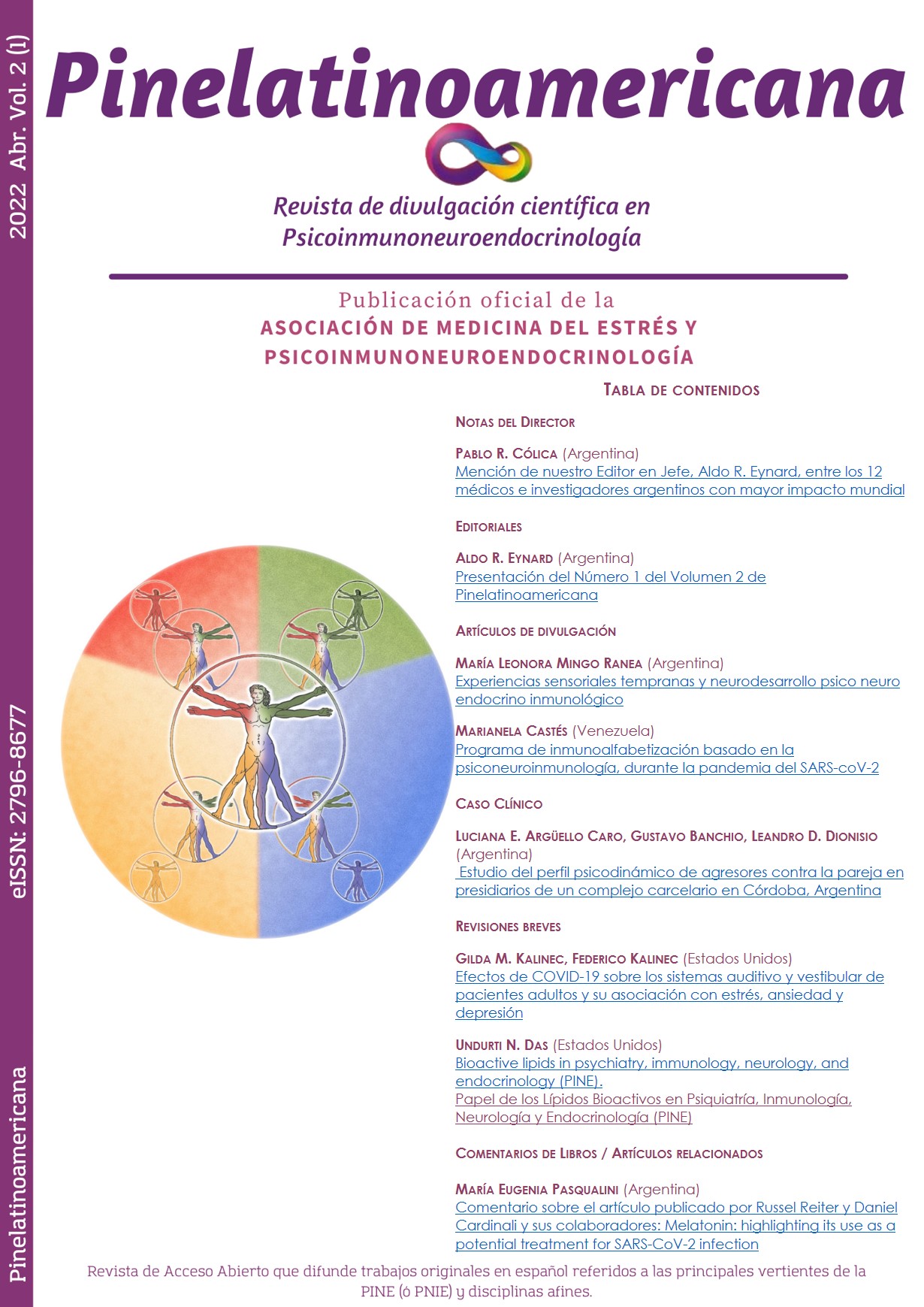Abstract
The coined term conceptualized as Immunoliteracy based on Psychoneuroimmunology (PNI) will be exposed. The biopsychoeducation program will be presented, using the concept of immunoliteracy, through which, using the new communication tools offered by technology it was possible to provide qualified scientific information and tools to more than 100,000 people from 75 countries, since the start of the pandemic in March 2020. Immunological aspects related to the pandemic caused by the SARS-CoV-2 virus will be discussed, as well as its consequences on global mental health that still persists. Emphasis will be placed on two tools: the immunocompetent personality test and two guided imagery exercises that were made available to people, named: the immunological adventure and the immunological adventure against COVID-19. The validity of the immunoliteracy program will be discussed as a feasible, scientifically valid, and responsible alternative for the benefit of people's health, in the current circumstances.
References
Ader, R., y Cohen, N. (1975). Behaviorally conditioned immunosuppression. Psychosomatic medicine, 37(4), 333–340. https://doi.org/10.1097/00006842-197507000-00007
Azkur, A. K., Akdis, M., Azkur, D., Sokolowska, M., van de Veen, W., Brüggen, M. C., O'Mahony, L., Gao, Y., Nadeau, K., y Akdis, C. A. (2020). Immune response to SARS-CoV-2 and mechanisms of immunopathological changes in COVID-19. Allergy, 75(7), 1564–1581. https://doi.org/10.1111/all.14364
Besedovsky, H. O., del Rey, A., Klusman, I., Furukawa, H., Monge Arditi, G., y Kabiersch, A. (1991). Cytokines as modulators of the hypothalamus-pituitary-adrenal axis. The Journal of steroid biochemistry and molecular biology, 40(4-6), 613–618. https://doi.org/10.1016/0960-0760(91)90284-c
Blalock J. E. (1994). Shared ligands and receptors as a molecular mechanism for communication between the immune and neuroendocrine systems. Annals of the New York Academy of Sciences, 741, 292–298. https://doi.org/10.1111/j.1749-6632.1994.tb23112.x
Capra, F. (2021). Patterns of connection: essential essays from five decades High Road Books, Albuquerque, USA.
Castés, M., Hagel, I., Palenque, M., Canelones, P., Corao, A., y Lynch, N. R. (1999). Immunological changes associated with clinical improvement of asthmatic children subjected to psychosocial intervention. Brain, behavior, and immunity, 13(1), 1–13. https://doi.org/10.1006/brbi.1999.0551
Castés, M., Isaacura, C., De Macedo, M., Campos, I., Torazzo, D y Chacin, L. F. (4-8 Junio de 2003). Endocrine, immunological and psychological changes associated with psychosocial intervention in patients with Diabetes Mellitus type II. [Resumen de presentación de la conferencia]. The psychoneuroimmunology research society 10th annual meeting, Amelia Island, Florida. Brain, behavior, and immunity, 17, 165 (21). https://doi.org/10.1016/S0889-1591(03)00024-2
Castés M. [Marianela Castes] (2021). Imaginación guiada intitulada: una aventura inmunológica. [Video]. https://www.youtube.com/watch?v=51SAqr5f4lc
Castés M. y Chang, V. [Marianela Castes] (2008). Vídeo: Los guardianes del cuerpo. [Video]. https://www.youtube.com/watch?v=ZtDKFJyxTYM
Castés, M. (2018). Inmunoalfabetizate y toma el control de tu salud. Psiconeuroinmunología. Editorial EDAF.
COVID-19 mental disorders collaborators (2021). Global prevalence and burden of depressive and anxiety disorders in 204 countries and territories in 2020 due to the COVID-19 pandemic. Lancet (London, England), 398(10312), 1700–1712. https://doi.org/10.1016/S0140-6736(21)02143-7
Grafton, S. T., Arbib, M. A., Fadiga, L., y Rizzolatti, G. (1996). Localization of grasp representations in humans by positron emission tomography. 2. Observation compared with imagination. Experimental brain research, 112(1), 103–111. https://doi.org/10.1007/BF00227183
Kiecolt-Glaser, J. K., & Newton, T. L. (2001). Marriage and health: his and hers. Psychological bulletin, 127(4), 472–503. https://doi.org/10.1037/0033-2909.127.4.472
Pert, C. B., Ruff, M. R., Weber, R. J., y Herkenham, M. (1985). Neuropeptides and their receptors: a psychosomatic network. Journal of immunology (Baltimore, Md.: 1950), 135(2 Suppl), 820s–826s.
Pocino, M., Luna G., Canelones, P., Mendoza, A., Romero, G., Palacios, LE., Rivas, L y Castés M. (2007). La relevancia de la intervención psicosocial en pacientes con cáncer de mama. Psicooncología, 4(1), 59-73. https://revistas.ucm.es/index,php/PSIC/article/view/PSICO707120059A
Solomon G. F. (1969). motions, stress, the central nervous system, and immunity. Annals of the New York Academy of Sciences, 164(2), 335–343. https://doi.org/10.1111/j.1749-6632.1969.tb14048.x
Solomon, G. F. (1981). Emotional and personality factors in the onset and course of autoimmune diseases, particularly rheumatoid arthritis. En Ader, R., Felten, D. y Cohen, N. Psychoneuroimmunology. (159-184). Academic Press.
Usher, K., Bhullar, N., Durkin, J., Gyamfi, N., y Jackson, D. (2020). Family violence and COVID-19: Increased vulnerability and reduced options for support. International journal of mental health nursing, 29(4), 549–552. https://doi.org/10.1111/inm.12735
Wright, J. H., y Caudill, R. (2020). Remote Treatment Delivery in Response to the COVID-19 Pandemic. Psychotherapy and psychosomatics, 89(3), 130–132. https://doi.org/10.1159/000507376

This work is licensed under a Creative Commons Attribution-NonCommercial 4.0 International License.
Copyright (c) 2022 Pinelatinoamericana

